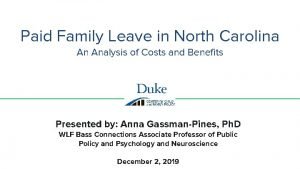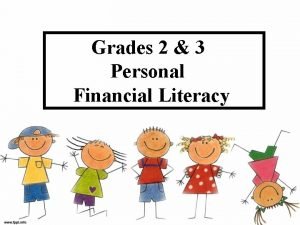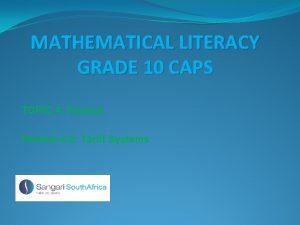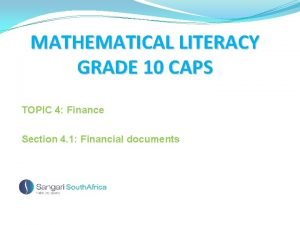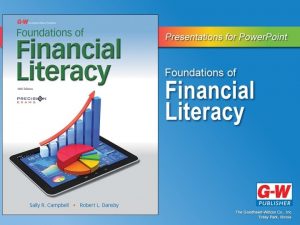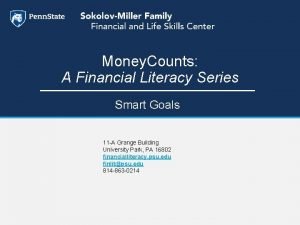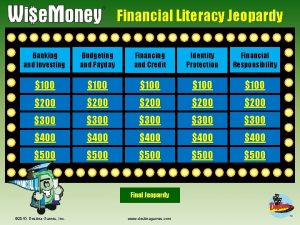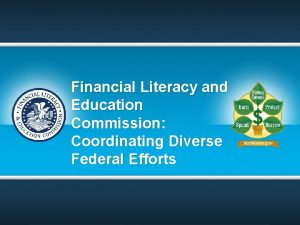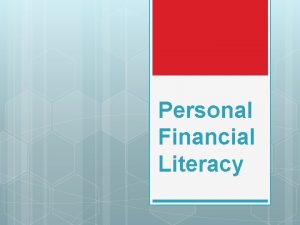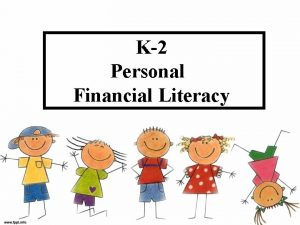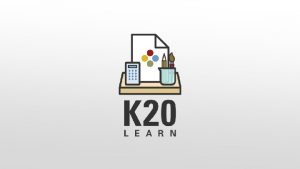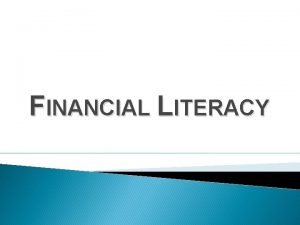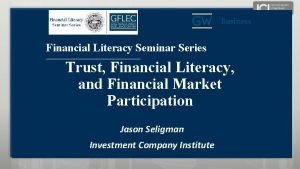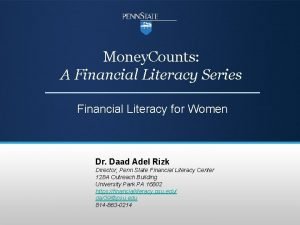Grades 4 5 Personal Financial Literacy The PFL













- Slides: 13

Grades 4 & 5 Personal Financial Literacy

The PFL Math TEKS-Savings Personal financial literacy. The student applies mathematical process standards to manage one’s financial resources effectively for lifetime financial security. Grade 4 • 4. 10 A: Distinguish between fixed and variable expenses 4. 10 B: calculate profit in a given situation • 4. 10 C compare the advantages and disadvantages of various savings options • 4. 10 D describe how to allocate a weekly allowance among spending; saving, including for college; and sharing • 4. 10 E: Describe the basic purpose of financial institutions, including keeping money safe, borrowing money, and lending 2

The PFL Math TEKS Personal financial literacy. The student applies mathematical process standards to manage one’s financial resources effectively for lifetime financial security. Grade 5 • 5. 10 A define income tax, payroll tax, sales tax, and property tax • 5. 10 B explain the difference between gross income and net income • 5. 10 C identify the advantages and disadvantages of different methods of payment, including check, credit card, debit card, and electronic payments 3

The PFL Math TEKS Personal financial literacy. The student applies mathematical process standards to manage one’s financial resources effectively for lifetime financial security. Grade 5 • 5. 10 D develop a system for keeping and using financial records • 5. 10 E describe actions that might be taken to balance a budget when expenses exceed income • 5. 10 F balance a simple budget 4

TCEE: Grade 4, Lesson 1 Not Enough Bucks Objective: 4. 10 A: Distinguish between fixed and variable expenses

Math 4. 1: Mathematical process standards. Math 4. 4 A: Add and subtract whole numbers and decimals to the hundredths place using the standard algorithm Math 4. 2 C: Compare and order whole numbers to 1, 000, 000 and represent comparisons using the symbols >, <, or = 6

K What you know Money can look like…. Cash in bills and coins Debit cards Credit cards Checks W What you want to know L What you Learned Money comes from…. Banks ATM machines Paychecks Money can help me buy things like Food Clothes Entertainment Toys Money can get me into financial trouble by Owing money I can’t repay Money can be saved and spent 7

8

TCEE: Grade 5, Lesson 4 Money In, Money Out Objectives: 5. 10 E: describe actions that might be taken to balance a budget when expenses exceed income 5. 10 F: balance a simple budget

• Math 5. 1: mathematical process standards • Math 5. 3 G: solve for quotients of decimals to the hundredths, up to four-digit dividends and two-digit whole number divisors, using strategies and algorithms, including the standard algorithm • Math 5. 3 K: add and subtract positive rational numbers fluently 10

11

12

Thank You from TCEE and Valerie Johse vjohse@aol. com 13
 Pfl outer banks
Pfl outer banks Financial literacy grade 4
Financial literacy grade 4 Personal financial literacy teks
Personal financial literacy teks Media literacy vs information literacy comparison
Media literacy vs information literacy comparison Media and information literacy (mil)
Media and information literacy (mil) What is people in media and people as media
What is people in media and people as media Cyber literacy for the digital age
Cyber literacy for the digital age Bhartiya model of financial literacy
Bhartiya model of financial literacy Maths literacy grade 11 tariffs
Maths literacy grade 11 tariffs Maths literacy grade 10 financial documents
Maths literacy grade 10 financial documents Chapter 1 financial literacy basics
Chapter 1 financial literacy basics Smart goals financial literacy
Smart goals financial literacy Money management jeopardy
Money management jeopardy Financial literacy and education commission
Financial literacy and education commission
